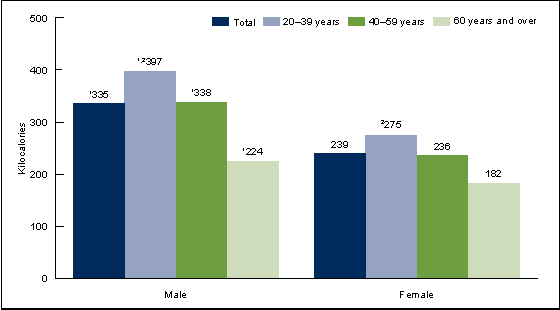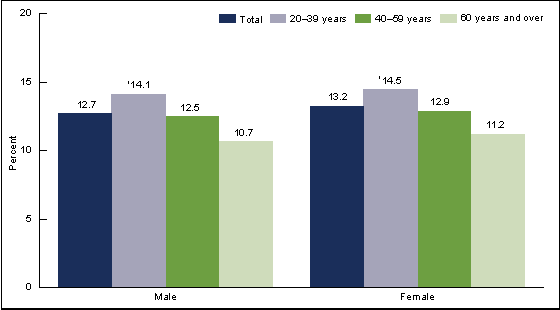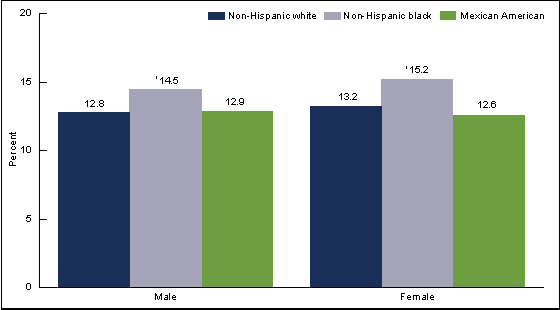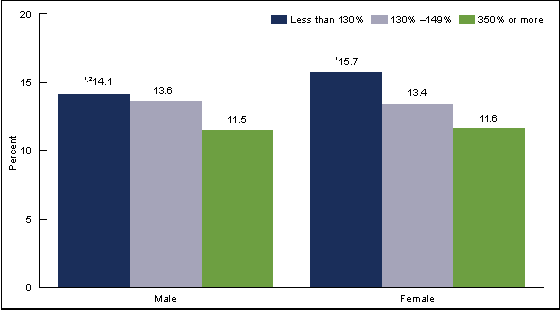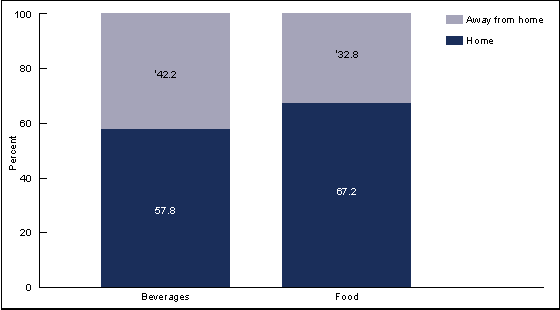Consumption of Added Sugars Among U.S. Adults, 2005–2010
- Key findings
- Does the mean number of calories consumed from added sugars differ by sex, and by age group?
- Are there differences in the percentage of total calories consumed from added sugars by age group?
- Are there differences in the percentage of total calories consumed from added sugars by race and ethnicity?
- Are there differences in the percentage of total calories consumed from added sugars by poverty level?
- Were adults more likely to consume the added sugars from foods and beverages at home or away from home?
- Summary
- Definitions
- Data source and methods
- About the authors
- References
- Suggested citation
NCHS Data Brief No. 122, May 2013
PDF Version (765 KB)
R. Bethene Ervin, Ph.D., R.D., and Cynthia L. Ogden, Ph.D., M.R.P.
Key findings
Data from the National Health and Nutrition Examination Survey, 2005–2010
- The mean percentage of total calories from added sugars decreased with increasing age and increasing income.
- Non-Hispanic black men and women consumed a larger percentage of their total calories from added sugars than non-Hispanic white and Mexican-American men and women.
- More of the calories from added sugars came from foods rather than beverages.
- More of the calories from added sugars were consumed at home rather than away from home.
Increased consumption of added sugars, which are sweeteners added to processed and prepared foods, has been linked to a decrease in intake of essential micronutrients (1,2) and an increase in body weight (3). The Dietary Guidelines for Americans, 2010 recommends limiting total intake of discretionary calories, including both added sugars and solid fats, to 5%–15% per day (4). Recent analyses indicate that children and adolescents obtain approximately 16% of their total caloric intake from added sugars (5). This data brief presents results for consumption of added sugars among U.S. adults for 2005–2010. Results are presented by sex, age, race and ethnicity, income, type of food consumed (food or beverage), and location of consumption.
Keywords: calories, income, National Health and Nutrition Examination Survey
Does the mean number of calories consumed from added sugars differ by sex, and by age group?
Men consumed more calories per day from added sugars than women. Men consumed an average of 335 kilocalories (kcals) from added sugars comparedwith 239 kcals for women (Figure 1). Caloric intake from added sugars decreased linearly with age for men and women. Men aged 20–39 consumed an average 397 kcals from added sugars, men aged 40–59 consumed an average 338 kcals from added sugars, and men aged 60 and over consumed an average 224 kcals from added sugars. Women aged 20–39 consumed an average 275 kcals from added sugars, women aged 40–59 consumed 236 kcals from added sugars, and women aged 60 and over consumed 182 kcals from added sugars.
Figure 1. Mean kilocalories from added sugars among adults aged 20 and over, by age group and sex: United States, 2005–2010
1Significantly different from females, p < 0.05.
2Significant linear trend by age, p < 0.05.
NOTE: Estimates that were not age-specific were age adjusted to the 2000 U.S. standard population using the three age groups shown.
SOURCE: CDC/NCHS, National Health and Nutrition Examination Survey, 2005–2010.
Are there differences in the percentage of total calories consumed from added sugars by age group?
A small but nonsignificant difference was observed in the percentage of total calories consumed from added sugars between men and women. Men consumed an average 12.7% of their calories from added sugars compared with 13.2% for women (Figure 2). The percentage of total calories contributed by added sugars decreased linearly with age for men and women. Men aged 20–39 consumed 14.1% of their calories from added sugars, men aged 40–59 consumed 12.5% of their calories from added sugars, and men aged 60 and over consumed 10.7% of their calories from added sugars. Women aged 20–39 consumed 14.5% of their calories from added sugars, women aged 40–59 consumed 12.9% of their calories from added sugars, and women aged 60 and over consumed 11.2% of their calories from added sugars.
Figure 2. Mean percentage of kilocalories from added sugars among adults aged 20 and over, by age group and sex: United States, 2005–2010
1Significant linear trend by age, p < 0.05.
NOTE: Estimates that were not age-specific were age adjusted to the 2000 U.S. standard population using the three age groups shown.
SOURCE: CDC/NCHS, National Health and Nutrition Examination Survey, 2005–2010.
Are there differences in the percentage of total calories consumed from added sugars by race and ethnicity?
Non-Hispanic black men consumed a larger percentage of their total calories from added sugars than non-Hispanic white and Mexican-American men (Figure 3). Non-Hispanic black men consumed 14.5% of their calories from added sugars compared with 12.8% for non-Hispanic white men and 12.9% for Mexican-American men. Non-Hispanic black women also consumed a larger percentage of their total calories from added sugars than non-Hispanic white and Mexican-American women. Non-Hispanic black women consumed 15.2% of their calories from added sugars compared with 13.2% for non-Hispanic white women and 12.6% for Mexican-American women. No significant differences in percentage of calories from added sugars were found between non-Hispanic white and Mexican-American men or women.
Figure 3. Mean percentage of kilocalories from added sugars among adults aged 20 and over, by race and ethnicity and sex: United States, 2005–2010
1Significantly different from non-Hispanic white and Mexican-American adults, p < 0.05.
NOTES: Persons of other race and ethnicity are not shown. Estimates were age adjusted to the 2000 U.S. standard population using three age groups: 20–39, 40–59, and 60 and over.
SOURCE: CDC/NCHS, National Health and Nutrition Examination Survey, 2005–2010.
Are there differences in the percentage of total calories consumed from added sugars by poverty level?
The percentage of total calories contributed by added sugars decreased linearly with increasing income for men and women (Figure 4). Men in the lowest income category consumed 14.1% of their calories from added sugars, while men in the middle income category consumed 13.6% of their calories from added sugars, and men in the highest income category consumed 11.5% of their calories from added sugars. Women in the lowest income category consumed 15.7% of their calories from added sugars, while women in the middle income category consumed 13.4% of their calories from added sugars, and women in the highest income category consumed 11.6% of their calories from added sugars.
Figure 4. Mean percentage of kilocalories from added sugars among adults aged 20 and over, by poverty level and sex: United States, 2005–2010
1Significant linear trend by poverty level, p < 0.05.
2Significantly different from females, p < 0.05.
NOTE: Estimates were age adjusted to the 2000 U.S. standard population using three age groups: 20–39, 40–59, and 60 and over.
SOURCE: CDC/NCHS, National Health and Nutrition Examination Survey, 2005–2010.
Were adults more likely to consume the added sugars from foods and beverages at home or away from home?
Foods contributed 67% of calories from added sugars compared with 33% from beverages (data not shown in Figure 5). Nearly two-thirds of the added sugars consumed from foods were consumed at home (67.2%), compared with 58% of added sugars calories from beverages (57.8%) (Figure 5). These results for added sugars intakes are consistent with those for total caloric intakes. That is, 67% of the total calories that adults consumed were consumed at home. The remainder was consumed away from home (data not shown in Figure 5).
Figure 5. Percentage of kilocalories from added sugars among adults aged 20 and over, by type of food and where the food was consumed: United States, 2005–2010
1Significantly different from percentage of added sugars consumed at home, p < 0.05.
NOTE: Estimates were age adjusted to the 2000 U.S. standard population using three age groups: 20–39, 40–59, and 60 and over.
SOURCE: CDC/NCHS, National Health and Nutrition Examination Survey, 2005–2010.
Summary
Approximately 13% of adults’ total caloric intakes came from added sugars between 2005 and 2010. These results are still relatively high, given that the Dietary Guidelines for Americans, 2010 recommendation is that no more than 5% to 15% of calories should come from solid fats and added sugars (4). Men consumed a larger absolute amount of calories from added sugars than women, but not when their added sugars intakes were expressed as a percentage of total calories. Non-Hispanic black men and women consumed a larger percentage of calories from added sugars than non-Hispanic white or Mexican-American men and women, and the percentage of calories from added sugars declined with increasing age and income.
The differences seen between subgroups of adults are not consistent with differences observed in youth. The percentage of calories from added sugars increased with increasing age for children and adolescents, but there was no difference in added sugars consumption between income groups. Non-Hispanic white children and adolescents consumed a larger percentage of their total calories from added sugars than their Mexican-American counterparts, but their intakes were not significantly different from non-Hispanic black children and adolescents (5).
The majority of added sugars were obtained from foods in comparison to beverages. However, previous research has shown that when foods and beverages are separated into specific food or beverage items, regular sodas are the leading food source of added sugars, at least for adults aged 18–54 (6). Results presented here show that among adults, one-third of calories from added sugars (33%) came from beverages. In children and adolescents, 40% of calories from added sugars came from beverages (5). Regardless of whether the added sugars are from food or beverages, the majority of the calories from added sugars as well as total calories are consumed at home by both adults and youth.
Definitions
Calories compared with kilocalories: A calorie is a measure of the energy produced as foods or beverages are burned for energy in the body. The term calorie is usually used when discussing energy from foods and diets, but the calorie being referred to is actually a kilocalorie (7). In this report, the term calorie refers to kilocalorie. Calories from added sugars represent the energy from added sugars. The percentage of daily calories from added sugars represents the percentage of total daily energy obtained from added sugars.
Added sugars: Added sugars include all sugars used as ingredients in processed and prepared foods such as breads, cakes, soft drinks, jams, chocolates, and ice cream, and sugars eaten separately or added to foods at the table. Examples of added sugars [PDF – 348 KB] include white sugar, brown sugar, raw sugar, corn syrup, corn syrup solids, high fructose corn syrup, malt syrup, maple syrup, pancake syrup, fructose sweetener, liquid fructose, honey, molasses, anhydrous dextrose, crystal dextrose, and dextrin.
Type of food consumed: A measure indicating whether the source of the added sugars was a food or beverage. Beverages include milk and milk substitutes, sugar drinks (fruit drinks, sodas, energy and sports drinks, and sweetened bottled water), fruit juices, nectars, vegetable juices, coffee, tea, and alcoholic beverages. Food includes anything that was not classified as a beverage.
Location of added sugars consumption: Respondents to the 24-hour dietary recall interview were asked where each reported food or beverage was consumed—at home or away from home.
Percent of federal poverty level: An index based on the ratio of family income to poverty. The U.S. Department of Health and Human Services’ (HHS) poverty guidelines were used as the poverty measure to calculate this index (8). These guidelines are issued each year, in the Federal Register, for determining financial eligibility for certain federal programs such as Head Start, Supplemental Nutrition Assistance Program or SNAP (formerly Food Stamp Program), Special Supplemental Nutrition Program for Women, Infants, and Children or WIC, and the National School Lunch Program.
Data source and methods
Data from the National Health and Nutrition Examination Survey (NHANES) were used for these analyses. NHANES is a cross-sectional survey designed to monitor the health and nutritional status of the civilian noninstitutionalized U.S. population (9). The survey consists of interviews conducted in participants’ homes, standardized physical examinations in mobile examination centers (MECs), and laboratory tests utilizing blood and urine specimens provided by participants during the physical examination. Dietary information for this analysis was obtained via an in-person 24-hour dietary recall interview in the MEC.
The NHANES sample is selected through a complex, multistage design that includes selection of primary sampling units (counties), household segments within the counties, households within segments, and, finally, sample persons from selected households. The sample design includes oversampling to obtain reliable estimates of health and nutritional measures for population subgroups. For survey years 2005–2006, African-American and Mexican-American subgroups were oversampled. For 2007–2008, African-American and overall Latino subgroups were oversampled, with sufficient sample sizes for analysis of the Mexican-American subgroup. In 1999, NHANES became a continuous survey, fielded on an ongoing basis. Each year of data collection is based on a representative sample covering all ages of the civilian noninstitutionalized population. Public-use data files are released in 2-year cycles.
Sample weights, which account for the differential probabilities of selection, nonresponse, and noncoverage, were incorporated into the estimation process. The standard errors of the percentages were estimated using Taylor Series Linearization, a method that incorporates the sample weights and sample design.
Differences between groups were evaluated using a t statistic at the p < 0.05 significance level. Test for trends by age were evaluated using linear regression, and the significance level was set at p < 0.05. All differences reported are statistically significant unless otherwise indicated. Statistical analyses were conducted using SAS System for Windows (release 9.3; SAS Institute Inc., Cary, N.C.) and SUDAAN (release 10.0; RTI International, Research Triangle Park, N.C.).
About the authors
R. Bethene Ervin and Cynthia L. Ogden are with the Centers for Disease Control and Prevention’s National Center for Health Statistics, Division of Health and Nutrition Examination Surveys.
References
- Marriott BP, Olsho L, Hadden L, Conner P. Intake of added sugars and selected nutrients in the United States, National Health and Nutrition Examination Survey (NHANES) 2003–2006. Crit Rev Food Sci Nutr 50(3):228–58. 2010.
- Bowman SA. Diets of individuals based on energy intakes from added sugars. Family Economics and Nutrition Review. 12(2):31–8. 1999.
- Vartanian LR, Schwartz MB, Brownell KD. Effects of soft drink consumption on nutrition and health: A systematic review and meta-analysis. Am J Public Health 97:667–75. 2007.
- U.S. Department of Agriculture and U.S. Department of Health and Human Services. Dietary Guidelines for Americans, 2010. 7th ed. Washington, DC: U.S. Government Printing Office. 2010.
- Ervin RB, Kit BK, Carroll MD, Ogden CL. Consumption of added sugar among U.S. children and adolescents, 2005–2008. NCHS data brief, no 87. Hyattsville, MD: National Center for Health Statistics. 2012.
- Welsh JA, Sharma AJ, Grellinger L, Vos MB. Consumption of added sugars is decreasing in the United States. Am J Clin Nutr 94(3):726–34. 2011.
- Energy. In: Food, nutrition & diet therapy. 7th ed. Krause MV, Mahan LK, editors. Philadelphia, PA: WB Saunders Company. pp. 9–23. 1984.
- U.S. Department of Health and Human Services. Poverty guidelines, research, and measurement: The 2011 HHS poverty guidelines. Washington, DC. 2011.
- National Center for Health Statistics. National Health and Nutrition Examination Survey: Questionnaires, datasets, and related documentation.
Suggested citation
Ervin RB, Ogden CL. Consumption of added sugars among U.S. adults, 2005–2010. NCHS data brief, no 122. Hyattsville, MD: National Center for Health Statistics. 2013.
Copyright information
All material appearing in this report is in the public domain and may be reproduced or copied without permission; citation as to source, however, is appreciated.
National Center for Health Statistics
Charles J. Rothwell, M.S., Acting Director
Jennifer H. Madans, Ph.D., Associate Director for Science
Division of Health and Nutrition Examination Surveys
Kathryn S. Porter, M.D., M.S., Director
